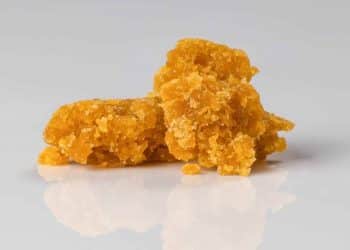Today, cannabis consumers have a diverse range of consumption options at their fingertips. It’s not uncommon to find topicals, lotions, balms, flower, concentrates, and edibles on most dispensary shelves.Concentrates, in particular, have become increasingly popular with cannabis consumers as an economical and potent way to medicate.
This is primarily due to the fact that cannabis concentrates have much higher levels of tetrahydrocannabinol (THC), ranging from about 24% to 76%, as one study found in 56 out of 57 concentrate samples. [1] In addition, concentrates can be consumed in multiple ways including vaporizers, dab rigs, and even simply ‘topping’ flower in a bowl.
Dabbing utilizes a water-pipe device, commonly referred to as a “rig.” All rigs have a “nail,” which is a titanium, ceramic, quartz, or glass-based platform that is heated with a blowtorch. This high level of heat allows for the rapid vaporization of concentrates.
So, how does dabbing differ from smoking? In both cases, the consumer is still heating the product to create smoke/vapor for inhalation. The crucial difference between smoking and dabbing lies in plant matter. Unlike smoking, which uses the cured cannabis flower, concentrates are devoid of plant biomass. This means that the user is not introduced to the myriad of by-products from the combustion of flower. [2]
Despite the removal of combustible biomass, the extraction process can introduce other contaminants, some of which are not found in cannabis flower, such as leftover solvents used in stripping the plant of its desired phytomolecules. In the case of solvent-based extraction methods like butane hash oil (BHO) preparation, there is increasing interest amongst consumers, manufacturers, and researchers regarding the true ‘purity’ of concentrates and whether any contaminants are above permissible thresholds, or present at all. A recent study on overall levels of contamination in concentrates found that one-third of all samples contained pesticides. [3] Furthermore, residual solvents were detected at a staggering 83%! [3] This is a result of poor post-processing and refinement following the extraction of cannabinoids and other phytomolecules from the biomass.
Due to the often high-levels of THC in cannabis concentrates, users may lack the same amount of control in comparison to smoking flower. Although it’s obviously true that users can increase/decrease the amount of concentrate applied to the nail, the potency remains constant. Therefore, it’s best for newer users to pace themselves and vaporize smaller amounts of the concentrate to gauge the physiological effects.
Although dabbing and the ingestion of cannabis concentrates are in vogue, scientific and medical research regarding cannabis concentrates has not yet caught up. We’ve discussed a couple of the available studies on dabbing, and the potential exposure to higher concentrations of contaminants from unclean products. Another paper that explored dabbing and the detrimental by-products from the egregious heating of terpenes, presented more of a worst-case, rather than a real-world scenario. [4, 5] Perhaps as more studies on concentrates are endeavored, we’ll get a more comprehensive portrayal regarding the relative safety of dabbing as a consumption method.
References
Alzghari, K. et. al. “To Dab or Not to Dab: Rising Concerns Regarding the Toxicity of Cannabis Concentrates.” 2017; 9(9): e1676. [Times cited = 1, Journal impact factor = unknown]
ElSohly, H. & ElSohly, M. “Marijuana Smoke Condensate”, in Marijuana and the Cannabinoids, Edited by M. Elsohly, Forensic Science and Medicine. Humana Press, 2007.
Raber, J. et. al. “Understanding dabs: contamination concerns of cannabis concentrates and cannabinoid transfer during the act of dabbing.” The Journal of Toxicological Sciences. 2015; 40(6): Pages 797-803 [Times cited = 22, Journal impact factor = 4.081].
Meehan-Atrash, J. et al. “Toxicant Formation in Dabbing: The Terpene Story”, ACS Omega, 2017, 2 (9), pp 6112–6117. [Times cited = 22, Journal impact factor = 4.081]
Troiani, M. “Toxicant Formation from Terpenes Deconstructed”, Terpenes and Testing Magazine, Issue 9, May/June 2018.
Photo courtesy of CannabisNow












